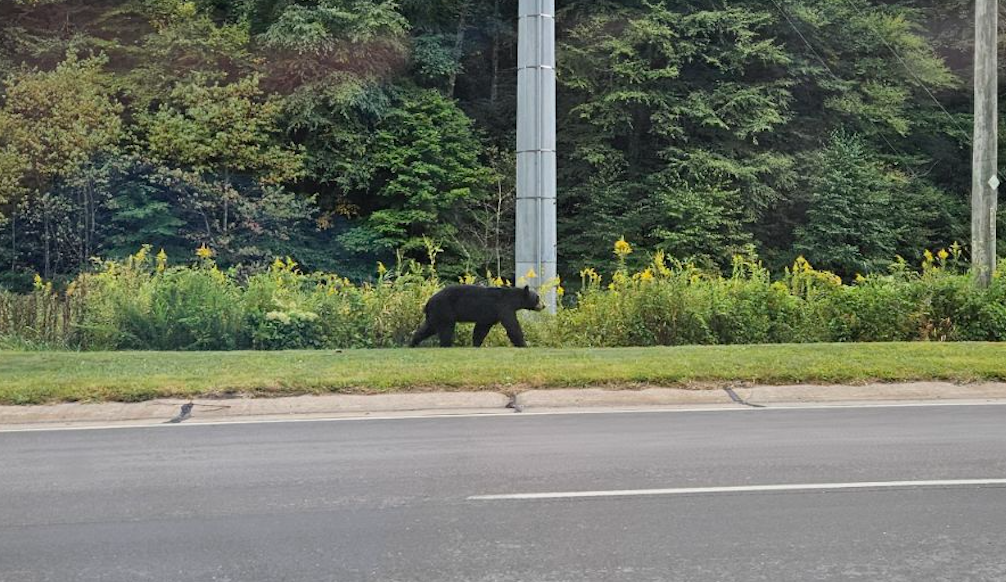There’s an old joke.
Two guys are out in the woods walking through a field when, suddenly, they see a large bear looking right at them, appearing ready to come after them.
One man turns to the other and says, “Oh my God, what do we do?!
The other says, “Run?”
“Run?? Are you crazy? We’ll never outrun that bear,” came the response.
“Well,” says the other man, “I don’t have to outrun the bear, I just have to outrun you.”
Jokes aside, black bears almost died out in North Carolina years ago, however, a massive conservation effort worked and now the bear population in the state is large and growing.
Simultaneously, more and more of Guilford County is being turned into roads, apartments, businesses and shopping centers, which means there’s less natural habitat for the bears to frolic.
So, it was no surprise on Friday, Sept. 13, when people traveling near the intersection of North Elm Street and East Cone Boulevard in Greensboro, at 3:45 p.m. got to see a highly unusual site for that area – a bear (seen above) strolling along the road, apparently oblivious to the fact that it was not at a place where it should be.
Black bears aren’t considered by wildlife officials to be particularly dangerous to humans; however, officials caution that you should certainly keep your distance if you want to remain safe.
As more and more construction takes place in Greensboro and Guilford County – and natural habitats are being taken away from the animals – more bears are being spotted on roads and in other places where they were seen only rarely before.
But, still, bear sightings in the section of the city near North Elm and Cone are unusual.
It’s already not unusual, however, for residents of Kirkwood or Irving Park to see deer and foxes roaming through their yards, along the road, or across the Greensboro Country Club golf course.
Koury Corporation’s massive new luxury apartment project between Cone Boulevard and Cornwallis was met with objections from people who didn’t want more traffic, commotion, and housing density in that area, however, one thing that many may not have considered about the project is that it’s destroying one of the few large completely natural spaces in that area. A lot of wildlife lives there and will be on the move soon.
According to the NC Wildlife Resources Commission, the bear population in North Carolina has grown to a point where sightings will be more common.
In June, for instance, a black bear was spotted on Burnt Poplar Road in Greensboro, while another was caught on a Ring Doorbell cam in Archdale. In recent years, local newscasts and social media sites have reported on quite a few bear sightings in neighborhoods.
Most of the bears spotted in urban areas – such as the one above – aren’t cubs, but they also usually aren’t fully grown. Wildlife officials say that black bears, once they get large enough, instinctively move as far away from their mother as possible to find mates elsewhere in the state – essentially to avoid too much in-breeding.
That can mean traveling from the mountains toward the coast or vice versa which will take them through Guilford County in many cases.
Summer is the time when black bears are most expected to be spotted in urban areas.
One of the saddest bear stories ever to come out of Guilford County came in 2011 at Piedmont Triad International Airport, when police, fire fighters and wildlife officials chased and killed a bear that had wandered near the runway.
Airport officials claimed the bear threatened the safety of planes, and several attempts to scare the bear away didn’t work. Eventually, they said, the bear turned and “raised on its hind legs and came back at a pretty good pace.”
The bear was first shot with a shotgun and then a wildlife official killed it with another shot.
The NC Wildlife Association notes: “Due to rising bear and human populations, bears and people are increasingly coming into contact with each other in many parts of the state. To avoid negative interactions, bears should never have access to human foods, garbage, pet food or bird food. Feeding bears rewards them for coming into residential areas. Bears feeding on unnatural food sources around your home may lose their fear of humans and will be more likely to approach people — a situation that rarely ends well for the bear and could have potential safety issues for humans as well.”
If you see a bear, they say, stay calm and keep a safe distance. If you suddenly encounter a bear at close range, like the two men in the opening joke, you’re supposed to back away slowly and make lots of noise.
Once you’re a safe distance from the bear, “Enjoy watching this amazing animal!”
Here are some more tips from state wildlife officials if you see one:
- Don’t feed them!
- Get rid of bird feeders and any trash they can easily access.
- Call the NC Wildlife helpline at 866-318-2401.
NC Wildlife officials also said it’s important to keep in mind that bears don’t stay in one place very long. They’re constantly on the move and, importantly, they aren’t coming after your pets. Still, they add, it’s best to keep your dog on a leash if you encounter a bear in your yard.
The Rhino Times would advise both the person and the dog to go inside and watch from there.


THAT’S JUST UNBEARABLE!